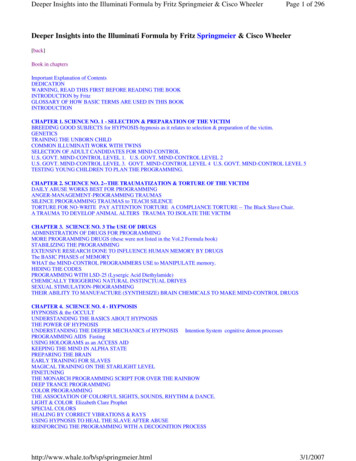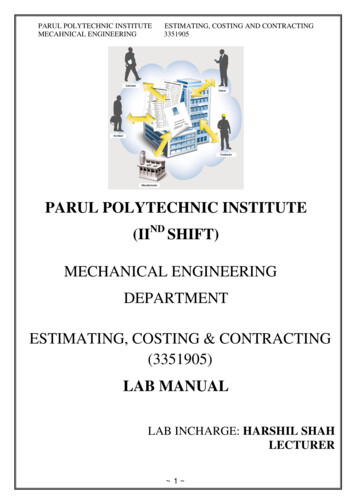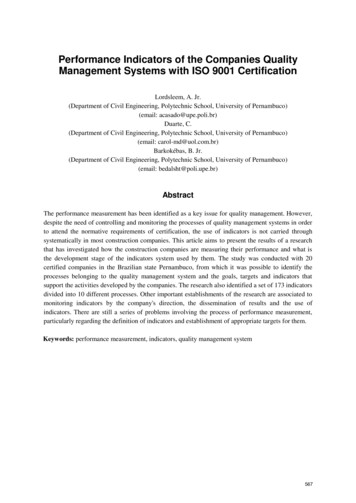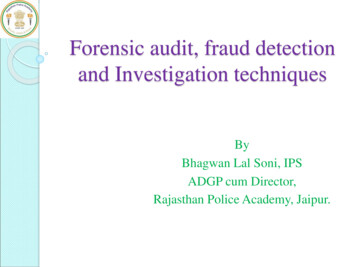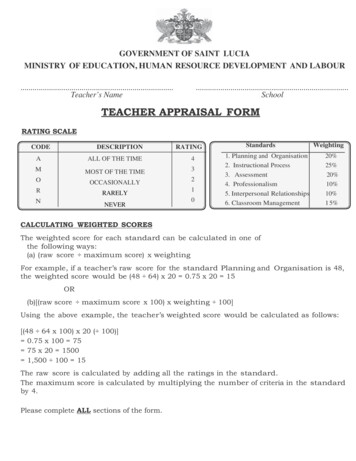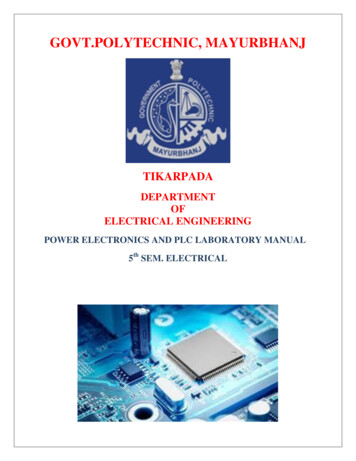
Transcription
GOVT.POLYTECHNIC, MAYURBHANJTIKARPADADEPARTMENTOFELECTRICAL ENGINEERINGPOWER ELECTRONICS AND PLC LABORATORY MANUAL5th SEM. ELECTRICAL
DOS It is COMPULSORY to wear covered shoes when entering the lab. You must keep your bags at the designated area. Bags should NOTbe placed on or under the workbench. Chairs and stools should be kept under the workbenches when notin use. Sit upright on chairs or stools, keeping feet on the floor. Follow the instructions of your lab demonstrator while conductingthe experiments. In an emergency, all power in this lab can be switched off bypressing the button on the main breaker panel. It is to be used foremergencies ONLY.DON’TS Do NOT transfer equipment to other workbench or other labswithout permission. Do NOT touch any equipment until you are told to do so. Wearing a ring or watch can be hazardous in an electrical labsince such items make good electrodes for the human body NO food and drinks are allowed in this lab. NEVER touch any equipment’s or components with wet or damphands.2
Pr.2 POWER ELECTRONICS & PLC LABName of the Course: Diploma in Electrical EngineeringCourse code:Pr.2SemesterTotal Period:45ExaminationLab. periods:3 P / weekTerm WorkMaximum marks: 75End SemesterExamination:5th3hrs2550LIST OF EXPERIMENTS(I) Power Electronics1. Study of switching characteristics of a power transistor.2. Study of V-I characteristics of SCR.3. Study of V-I characteristics of TRIAC.4. Study of V-I characteristics of DIAC.5. Study of drive circuit for SCR & TRIAC using DIAC.6. Study of drive circuit for SCR & TRIAC using UJT.7. To study phase controlled bridge rectifier using resistive load.8. To study series Inverter.9. Study of voltage source Inverter.10. To perform the speed control of DC motor using Chopper.11. To study single-phase Cyclo-converter.(II) PLC Programming1. Introduction/Familiarization PLC Trainer & its Installation with PC(a) Learn the basics and hardware components of PLC.(b) Understand configuration of PLC system.3
(c) Study various building blocks of PLC.(d) Determine the No. of digital I/O & Analog I/O.2. Execute the different Ladder Diagrams(a) Demonstrate PLC and Ladder diagram-Preparation downloading and running.(b) Execute Ladder diagrams for different Logical Gates.(c) Execute Ladder diagrams using timers & counters.3. Execute the Ladder Diagrams with model applications.(i) DOL starter (ii) Star- Delta starter.4. Execute Ladder diagrams with model applications (i) Stair case lighting (ii)Traffic light controller.4
TABLE OF 4Name of the ExperimentsPower ElectronicsStudy of switching characteristics of a power transistorStudy of V-I characteristics of SCRStudy of V-I characteristics of TRIACStudy of V-I characteristics of DIACStudy of drive circuit for SCR & TRIAC using DIACStudy of drive circuit for SCR & TRIAC using UJTTo study phase controlled bridge rectifier using resistive loadTo study series InverterStudy of voltage source InverterTo perform the speed control of DC motor using ChopperTo study single-phase Cyclo-converterPLC ProgrammingIntroduction/Familiarization PLC Trainer & its Installation withPCLearn the basics and hardware components of PLCUnderstand configuration of PLC systemStudy various building blocks of PLCDetermine the No. of digital I/O & Analog I/OExecute the different Ladder DiagramsDemonstrate PLC and Ladder diagram-Preparation downloadingand runningExecute Ladder diagrams for different Logical GatesExecute Ladder diagrams using timers & countersExecute the Ladder Diagrams with model applications(i) DOL starter(ii) Star- Delta starterExecute Ladder diagrams with model applications(i) Stair case lighting(ii) Traffic light -3233-3435-3738-4142-76
Experiment No: 011. AIM-Switching Characteristics of Transistor.2. APPARATUS REQUIRED:Sl.No. Apparatus1CRO234567Function GeneratorResistorTransistorD.C Power SupplyConnecting wiresBread boardSpecificationQuantity0-20MHz (DualChannel)1Hz– 1 MHz1Kῼ-100KῼBC l070-30V-1No.1No.1No. each1No.1No.As required1No.Theory:The Transistor can act as a switch. To operate the transistor as a switch, it has to beoperated in saturation region for ON state and to be operated in cut off regionfor OFF state.Power BJT has 3 terminals — collector, base and emitter. It is a current controlleddevice. It is the base current that controls the devicePower Metal Oxide Semiconductor Field Effect Transistor (MOSFET) has 3terminals — Drain, Source and Gate. It is a voltage controlled device. It is the gatevoltage that controls the device.6
Insulated Gate Bipolar Transistor (IGBT) has 3 terminals — Collector, Emitterand Gate. It is also a voltage controlled device. It is the gate voltage that controlsthe device.Procedure:1. Connect the circuit as shown in the above figure.2. Apply the Square wave of 4 Vp-p at frequency of l KHz.3. Observe the waveforms at Collector and Base of the transistor and plot it.CONCLUSION:Hence, we verified the above experiment.7
Experiment No: 021. AIM: Study of V-I characteristics of SCR2. APPARATUS REQUIRED:SI.No123456ApparatusSCR KitVoltmeterAmmeterAmmeterResisterPatch cardsSpecification0- 50V DC0-500 mA DC0-25mA DC100omh-Quantity11111As per required3. THEORY:An elementary circuit diagram for obtaining static V-I characteristics of a thyristoris shown in Fig. (a). The anode and cathode are connected to main source throughthe load. The gate and cathode are fed from a source Es which provides positivegate current from gate to cathode.8
Fig. (b) Shows static V-I characteristics of a thyristor. Here Va is the anode voltageacross thyristor terminals A, K and Ia is the anode current. Typical SCR V-Icharacteristicshown in Fig. (b) reveals that a thyristor has three basic modes ofoperation; namely, reverse blocking mode, forward blocking (off-state) mode andforward conduction (on-state) mode. These three modes of operation are nowdiscussed below:Reverse Blocking Mode: When cathode is made positive with respect to anodewith switch S open, Fig. (a), thyristor is reverse biased. Junctions J1 J3 are seen tobe reverse biased whereas junction J2 is forward biased. The device behaves as iftwo diodes are connected in series with reverse voltage applied across them. Asmall leakage current of the order of a few mill amperes (or a few microamperesdepending upon the SCR rating) flows. This is reverse blocking mode, called theoff-state, of the thyristor. If the reverse voltage is increased, then at a criticalbreakdown level, called reverse break-down voltage VBR, an avalanche occurs atJ1 and J3 and the reverse current increases rap-idly. A large current associated withVBR gives rise to more losses in the SCR. This may lead to thyristor damage asthe junction temperature may exceed its permissible temperature rise. It should,therefore, be ensured that maximum working reverse voltage across a thyristordoes not exceed VBR. When reverse voltage applied across a thyristor is less thanVBR, the device offers high impedance in the reverse direction. The SCR in thereverse blocking mode may therefore be treated as an open switch.Note that V-I characteristic after avalanche breakdown during reverse blockingmode is applicable only when load resistance is zero, Fig.(b). In case loadresistance is present, a large anode current associated with avalanche breakdown atVBR would cause substantial voltage drop across load and as a result, V-Icharacteristic in third quadrant would bend to the right of vertical line drawn atVBR.Forward Blocking Mode: When anode is positive with respect to the cathode,with gate circuit open, thyristor is said to be forward biased. It is seen from thisfigure that junctions J1, J3 are forward biased but junction J2 is reverse biased. Inthis mode, a small current, called forward leakage current, flows. In case theforward voltage is increased, then the reverse biased junction J2 will have anavalanche breakdown at a voltage called forward break over voltage VB0. Whenforward voltage is less than VBO, SCR offers high impedance. Therefore, athyristor can be treated as an open switch even in the forward blocking mode.9
4. CIRCUIT DIAGRAM:5. PROCEDURE: Connections are made as shown in the circuit diagram. The value of gate current IG, is set to convenient value by adjusting VGG. By varying the anode cathode voltage VAA gradually in step by step, notedown the cor-responding values of VAK and IA. Note down VAK and IA atthe instant of firing of SCRand after firing (by reducing the voltmeter rangesand ammeter ranges) then increase the supply voltage VAA. Note downcorresponding values of VAK and IA. The point at which SCR fires, gives the value of break over voltage VBO. A graph of VAK V/S IA is to be plotted. The on state resistance can be calculated from the graph by using a formula. The gate supply voltage VGG is to be switched off. Observe the ammeter reading by reducing the anode cathode supply voltageVAA .The point at which ammeter reading suddenly goes to zero gives thevalue of holding current IH Steps no.2, 3, 4, 5, 6, 7, 8 are repeated for another value of gate current IG. 10
6. OBSERVATION:For forward biasSI.NoVoltage (V)Current (mA)For reverse biasSI.NoCurrent (μA)Voltage (V)7. CONCLUSION:The V-I characteristics of silicon controlled rectifier is plotted on the graph whichis true according to theory.11
Experiment No: 031. AIM: Study of V-I characteristics of TRIAC2. APPARATUS REQUIRED:SI.No123456ApparatusTRIAC KITVoltmeterAmmeterAmmeterResisterPatch cardsSpecification0- 50V DC0-50 mA DC0-25mA DC100omh-3. THEORY:V-I characteristics of TRIAC12Quantity11112As per required
Typical V-I characteristics of a triacare shown in figure. The triac has on and offstate characteristics similar to SCR but now the characteristic is applicable to bothpositive and negative voltages. This is expected because triac consists of two SCRsconnected in parallel but opposite in directions.MT2 is positive with respect to MTX in the first quadrant and it is negative in thethird quad rant. As already said in previous blog posts, the gate triggering mayoccur in any of the following four modes.Quadrant I operation: VMT2, positive; VG1 positiveQuadrant II operation: VMT21 positive; VGl negativeQuadrant III operation: VMT21 negative; VGl negativeQuadrant IV operation: VMT21 negative; VG1 positiveWhere VMT21 and VGl are the voltages of terminal MT2 and gate with respect toterminal MT1.The device, when starts conduction permits a very heavy amount of current to flowthrough it. This large inrush of current must be restricted by employing externalresistance; otherwise the device may get damaged.The gate is the control terminal of the device. By applying proper signal to thegate, the firing angle of the device can be controlled. The circuits used in the gatefor triggering the device are called the gate-triggering circuits. The gate-triggeringcircuits for the triac are almost same like those used for SCRs. These triggeringcircuits usually generate trigger pulses for firing the device. The trigger pulseshould be of sufficient magnitude and duration so that firing of the device isassured. Usually, duration of 35 us is sufficient for sustaining the firing of thedevice.A typical triac has the following voltage/current values: Instantaneous on-state voltage – 1.5 Volts On-state current – 25 Amperes Holding current, IH - 75 Milli Amperes Average triggering current, IG – 5 Milli Amperes 13
4. CIRCUIT DIAGRAM:14
5. PROCEDURE:1. Connections are made as per the circuit diagram.2. Adjust the value of Ig to zero or some minimum value.3. By varying the voltage (Vmt1mt2) from 0- 10v, note down the correspondingvalues of current ( I1).4. Now apply the gate voltage gradually, until SCR fires, then note down thevalues of Ig and also the values of Vmt1mt2 and I1.5. Increase Vm to some value and note down Vmt1mt2 and I1.6. Reduce the gate voltage to zero; observe ammeter reading by reducing Vmwhich gives the values of IH (Holding current) at the point at which, currentsuddenly drops to zero.7. Repeat the above process 2,3,4,5,6 for different values of break overvoltages.8. Plot the graph of Vmt1mt2 Vs I16. OBSERVATION:For forward biasSI.NoVoltage (V)Current (mA)15
For reverse biasSI.NoCurrent (μA)Voltage (V)7. CONCLUSION:The V-I characteristics of TRIAC is plotted on the graph which is true according totheory.16
Experiment No: 041. AIM: Study of V-I characteristics of DIAC2. APPARATUS REQUIRED:SI.No123456ApparatusDIAC KITVoltmeterAmmeterAmmeterResisterPatch cardsSpecification0- 50V DC0-50 mA DC0-25mA DC100omh-Quantity11112As per required3. THEORY:A diac is an important member of the thyristor family and is usually employed fortrigger-ing triacs. A diac is a two-electrode bidirectional avalanche diode whichcan be switched from off-state to the on-state for either polarity of the appliedvoltage. This is just like a triacwithout gate terminal, as shown in figure. Itsequivalent circuit is a pair of inverted four layer diodes. Two schematic symbolsare shown in figure. Again the terminal designations are arbitrary since the diac,like triac, is also a bilateral device. The switching from off-state to on-state isachieved by simply exceeding the avalanche break down voltage in eitherdirection.17
Volt-ampere characteristic of a diac is shown in figure. It resembles the Englishletter Z because of the symmetrical switching characteristics for either polarity ofthe applied volt-age.The diac acts like an open-circuit until it‘s switching or break over voltage isexceeded. At that point the diac conducts until its current reduces toward zero(below the level of the holding current of the device). The diac, because of itspeculiar construction, does not switch sharply into a low voltage condition at a lowcurrent level like the SCR or triac. In-stead, once it goes into conduction, the diacmaintains an almost continuous negative resistance characteristic, that is, voltagedecreases with the increase in current. This means that, unlike the SCR and thetriac, the diac cannot be expected to maintain a low (on) voltage drop until itscurrent falls below a holding current level.4. CIRCUIT DIAGRAM:5. PROCEDURE:1. Connect the millimeter, DIAC, Voltmeter to the circuit.2. Switch on the power supply.3. Increase the supply voltage in steps; note the corresponding currents andvoltages for each step.4. Plot the graph of VI characteristics.5. Reverse the terminal of DIAC. Increase the supply voltage in steps; note thecorresponding currents and voltages for each step.6. Plot the graph of VI characteristics.18
6. OBSERVATION:For forward biasSI.NoVoltage (V)Current (mA)For reverse biasSI.NoCurrent (μA)Voltage (V)7. CONCLUSION:The V-I characteristics of DIAC is plotted on the graph which is true according totheory.19
EXPERIMENT NO- 51. AIM OF THE EXPERIMENT:Study of drive circuit for SCR & TRIAC using DIAC.2. APPARATUS REQUIRED:SL. No.Name of the EquipmentQuantity1Drive circuit for SCR and TRIAC using 1DIAC kit2Lamp (50V)13CRO13. THEORY:SCR‘s and Triacs, we saw that in ON-OFF switching applications, these devicescould be triggered by simple circuits producing steady state gate currents as shown.When switch, S1 is open no gate current flows and the lamp is ―OFF‖. Whenswitch S1 is closed, gate current IG flows and the SCR conducts on the positive halfcycles only as it is operating in quadrant Ι.We remember also that once gated ―ON‖, the SCR will only switch ―OFF‖ againwhen its supply voltage falls to values such that its Anode current, IA is less thanthe value of its holding current, IH.4. CIRCUIT DIAGRAM:20
5. PROCEDURE:1. Make the connection as per the circuit diagram.2. Connect the lamp at load terminal.3. Switch ON the mains supply, vary the firing angle potentiometer andObserve the variation in lamp brightness and also note down the voltage(ACvolts) variation across the lamp using multimeter.4. Write down these readings in table.5. Observe the wave form.6. OBSERVATION:SL.NO.Input Voltage AC involtsFiring angle indegrees7. CONCLUSION:Drive circuit for SCR and TRIAC using DIAC is studied.21Output voltage DCin Volts
EXPERIMENT NO- 61. AIM OF THE EXPERIMENT:Study of drive circuit for SCR & TRIAC using UJT.2. APPARATUS REQUIRED:SL. No.Name of the Equipment1Drive circuit for SCR andTRIAC using UJT kit2Resistive load3CRORangeQuantity125 watt113. THEORY:UJT Triggering circuit: A unit junction transistor (UJT) is an electronicsemiconductor device that has only one junction. The UJT has three terminals: anemitter (E) and two bases (B1 and B2). The base is formed by lightly doped n-typebar of silicon. Two ohmic contacts B1 and B2 are attached at its ends. The emitteris of p-type and it is heavily doped. The resistance between B1 and B2, when theemitter is open-circuited is called inter base resistance.Initially the capacitor charges through R whose voltage is applied to the emitterof UJT. When the capacitor voltage reaches peak point voltage of UJT.The UJT will switch to ON condition. Now the capacitor discharges through theoutput resistance. Thus the pulse is generated in the circuit.4. CIRCUIT DIAGRAM:22
5. PROCEDURE:1.2.3.4.5.6.The connections are made as per the circuit diagram given above.The R Load must be 60W bulb.When the load is Rheostat, then it must be in maximum position.Turn on the SW2 and observe the waveform across between G1&K1Turn ON SW1 and observe the waveform across the R load.Measure the X-axis time interval of ON time of Load Voltage and OFFTime of Load Voltage.7. Adjust the value of Firing angle and note down the load voltage.8. Repeat the step 6.9. Repeat the experiment for different values of α and note down Vo.6. OBSERVATION:Sl. NO.Firing AngleLoad Voltage7. CONCLUSION:UJT triggering circuit using SCR and TRIAC is constructed and found the loadvoltage for various firing angles.23
Experiment No: 071. AIM:To study phase controlled bridge rectifier using resistive load.2. APPARATUS REQUIRED:SI.No Apparatus1Single Phase FullyControlled BridgeRectifier module2CRO with probes3Resistive load4Multi Meter5Ammeter6RPS , Dual Channel7Transformer 230/0-30V8Connecting C)0-30V230/00-30V-121111As required3. THEORY:One important application of an SCR is the controlled half waverectification. The AC supply to be rectified is supplied at the anode. Let the peakinverse voltage appearing across secondary is less than the reverse breakdownvoltage of the SCR. This ensures that SCR will not breakdown during negative halfcycles of AC supply. The circuit action can be explained as follows:.i.ii.During the negative half cycles of AC voltage appearing across secondary,the SCR doesn‘t conduct irrespective of the gate voltage. In this conditionanode is negative w.r.t cathode and also PIV is less than reverse breakdownvoltage.The SCR will conduct during positive half cycles provided proper gatecurrent is made to flow. The larger the gate current, the lesser the supplyvoltage at which SCR is turned ON.The SCR half-wave rectifier can be compared with the ordinary half-waverectifier. The ordinary half-wave rectifier will conduct full positive half-cyclewhereas SCR half-wave rectifier can be made to conduct full or part of a positivehalf-cycle adjusting the gate current. Therefore, an SCR can control power fed tothe load and hence the name controlled rectifier.24
The SCR full wave rectifier, in all respects resembles theordinary center tap circuit except that the two diodes have been replaced by twoSCR‘s. The gates of both SCR‘s get their supply from the two gates controls. OneSCR conducts during the positive half cycle and the other during the negative halfcycle. Thus, full wave rectified output is obtained across the load. During thepositive half-cycle of AC across secondary, the upper end of secondary is positiveand lower end negative. SCR1 will conduct. During the negative half-cycle of ACinput the upper end of secondary becomes and the lower end positive. Now SCR2will conduct it may be noted that current through the load is in the same directionon both half-cycles of input AC. The advantage of this circuit over ordinary fullwave rectifier circuit is that by adjusting the gate currents, the conduction angleand so the output voltage can be changed.4. CIRCUIT DIAGRAM:(Controlled bridge rectifier using resistive load)25
5. PROCEDURE:For Half Wave Rectifier1. Connect the circuit as shown in Fig. (1) by connecting the dotted linethrough patch cords.2. To observe the change in phase angle connect CRO across voltmeter points.Connect load resistance (RL) in circuit by connecting dotted line thoughpatch cord. Also connect voltmeter, milli ammeter& AC voltmeter in thecircuit through patch cords.3. Set the load Resistance RL to 1 KΩ and switch ON the instrument as well asCRO.4. Now set the VR1 Potentiometer to get complete half wave rectified signal onCRO. Note down Average DC Voltage, DC Current & AC Ripples.Calculate the value of Ripple factor by using formula.Ripple Factor AC Ripples (Voltage) / DC Voltage(Standard value of Ripple Factor 1.21)26
5. Now change the firing angle of SCR by varying potentiometer VR1 andevery time note down the observations of Average DC voltage, Current &AC Ripples. Also note down Firing Angle from CRO.6. Also note down the observations of Voltage, Current & AC Ripples byvarying the Load Resistances (RL).For Full Wave Rectifier1. Connect the circuit as shown in Fig.(2) by connecting the dotted linesthrough patch cords.2. To observe the change in phase angle connect CRO across voltmeterpoints. Connect load resistance (RL) in the circuit by connecting dottedline through patch cord. Also connect voltmeter, milli ammeter& ACvoltmeter in the circuit through patch cords.3. Set the load Resistance RL to 1 KΩ and switch ON the instrument aswell as CRO.4. Now set VR1& VR2 Potentiometer to get complete full wave rectifiedsignal on CRO. Note down average DC voltage, DC current & ACripples. Calculate the value of Ripple factor by using formula :Ripple Factor AC Ripples (Voltage) / DC Voltage(Standard value of Ripple Factor 0.48)5. Now change the firing angle of SCR by varying potentiometer VR 1&VR2 and every time note down the observations of Average DC voltage,Current & AC Ripples. Also note down firing angle from CRO.6. Also note down the observations of Voltage, Current & AC supplies byvarying the load resistance (RL).For Fully Controlled Bridge Rectifier1. Connect the circuit as shown in Fig. (3) by connecting the dotted linethrough patch cords.2. To observe the change in phase angle connect CRO across voltmeter points.Connect load Resistance (RL) in the circuit by connecting dotted linethrough patch cord. Also connect Voltmeter, millimeter& AC Voltmeter inthe circuit through patch cords.3. Set the Load Resistance (RL) to 1KΩ and switch ON the instrument as wellas CRO.27
4. Now set the VR1, VR2, VR3, VR4 Potentiometers to get complete full waverectified (Through Bridge circuit) signal on CRO. Note down average DCvoltage, DC current & AC ripples. Calculate the value of Ripple factor usingformula:RippleFactor AC Ripples (Voltage)(Standard value of ripple factor 0.48)/DCVoltage5. Now change the firing angle of SCR by varying potentiometer VR1, VR2,VR3 & VR4 every time note down the observations of Average DC voltage,Current & AC Ripples. Also note down Firing Angle from CRO.6. Also note down the observations of Voltage, Current & AC Ripples byvarying the Load Resistances (RL).6. OBSERVATION:For Half Wave RectifierFiringAngleDC pleFactor ACvolts/DCvoltsFor Full wave RectifierFiringAngleDC ippleFactor ACvolts/DCvolts
For Bridge RectifierFiringAngleDC pleFactor ACvolts/DCvolts7. CONCLUSION:From the above experiment we studied the phase controlled bridge rectifier usingresistive load.29
Experiment No: 081. AIM:To study series Inverter.2. APPARATUS REQUIRED:Sl.No123456ApparatusSeries Inverter ModuleCROCapacitorInductorConnecting wirePatch cardsSpecification30MHz-Quantity1121As per requiredAs per required3. THEORY:The commutating components L and C are connected in series with the loadtherefore this inverter is called as SERIES INVERTER. The value of commutatingcomponents is selected such that the circuit becomes under damped. Theanode current itself becomes zero in this inverter resulting the SCR turns offautomatically therefore this inverter is also called as self commutated or loadcommutated inverter.4. CIRCUIT DIAGRAM:30
MODEL GRAPH5. PROCEDURE: To begin with switch on the power supply to the firing circuit checkthat trigger pulses by varying thefrequency. Connections are made as shown in the circuitdiagram. Now connect trigger outputs from the firing circuits to gate andcathode of SCRs T1 &T2. Connect DC input from a 30v/2A regulated power supply andswitch on the input DCsupply. Now apply trigger pulses to SCRs and observe voltage waveformacross theload.31
Measure Vorms& frequency of o/p voltagewaveform.6. OBSERVATION:Sl.No Amplitude in VoltTON (ms)7. CONCLUSION:Thus the operation of a series inverter is studied.32TOFF (ms)
Experiment No: 091. AIM:Study of voltage source Inverter.2. APPARATUS REQUIRED:SL. NO.EQUIPMENTREQUIREDSpecificationQUANTITY1inverter kit12CRO13. THEORY:Inverters are static power converters that produce an AC output waveform from aDC power supply. They are applied in adjustable AC speed drives, UninterruptiblePower Supplies (UPS), shunt active power filter, etc. For sinusoidal AC outputs,the magnitude, frequency, and phase should be controllable. If a DC input is avoltage source, then the inverter is called a Voltage Source Inverter (VSI).According to a number of phases, inverters are classified into two types1. Single Phase Voltage Source Inverter2. Three Phase Voltage Source Inverter4. CIRCUIT DIAGRAM:(Single Phase Voltage Source Inverter)33
(Three Phase Voltage Source Inverter)5. PROCEDURE:1.2.3.4.5.6.Switch on the firing circuit.Observe the trigger outputs by varying frequency potentiometer and byoperating ON/OFF switch.Then connect input DC supply to the power circuit. Connect trigger outputsto Gate and Cathode of SCR.Apply trigger pulses to SCR 4.Observe voltage waveforms across load. Output voltage is square waveonly.Vary the load, vary the frequency and observe waveforms.6. CONCLUSION:Hence we verified the above experiment.34
Experiment No: 101. AIM:To perform the speed control ofDC motor using Chopper.2. APPARATUS REQUIRED:SL.No1234ApparatusPower electronic kitServo motorDSOConnecting leadSpecificationQuantity111As per required3. THEORY:Circuit diagram is shown in fig. (1) and it consist of RC network whichcontrol the speed of motor. There are two method of Triggering to SCR using RCnetwork. They are explained below and we are using RC half wave circuit tocontrol the speed of motor .SCR is here acting as an half wave rectifier and allowsonly half cycle of ac signal to the armature. This is an method of voltage control ofarmature by using SCR whose firing angle is varied and accordingly voltage ofarmature is varied.RC FIRING CIRCUITS:The limited range of firing angle control by resistance firing circuit can beovercome by RC firing circuit .There are several variations of RC trigger circuits.Here only two of them are presented.(i) RC Half wave Trigger CircuitBy varying the value of R ,firing angle can be controlled from 0-180.Innegative half cycle ,capacitor c charges through resistance with lower platepositive to the peak supply voltage Vm at wt -900.after wt -900 ,sources voltageVS decreases from –Vm to zero. During this period capacitor voltage VC may fallfrom –Vm at wt -900 to some lower value at wt 00. Now, as the SCR anodevoltage passes through zero and becomes positive, C begins to charge throughvariable resistance R from the initial voltage. When capacitor charges to positivevoltage equal to gate trigger voltage Vgt SCR is fired and after this capacitor holds35
to a small positive voltage. Diode D1 is used to prevent the breakdown of cathodeto gate junction the negative half cycle. Firing angle α cannot lay to zero or 1800.The SCR will trigger when VC Vgt Vd, where Vd is the voltage dropacross diode D1. At the instant of triggering, if VC is assumed constant, the currentIgt must be supplied by voltage source through R, D1 and gate to cathode circuit.Hence the maximum value of R is given byVs Rlgt VcOrVs Rlgt Vgt VdOrR Vs Vdt VdIdt4. CIRCUIT DIAGRAM:36
5. PROCEDURE:1. Connect motor unit with main unit through patch cords as per the ckt diagram.2. Connect the main lead of instrument in the mains plug. Keep ―SET SPEED”potentiometer at minimum position initially i.e. fully anticlockwise and switch ONthe instrument.3. Very the speed of motor using ―SET SEED‖ potentiometer slowly. Note downthe reading on the current meter at equal interval of voltage in the observation tablegiven in the procedure.4. Connect the CRO across the SCR using attenuation lead and observe differentwave form at different firing angle.(Timing Diagram of Output Waveforms from the Chopper Circuit)6. CONCLUSION:Hence we proved the experiment and traced the wave form.37
Experiment No: 111. AIM:To study single-phase Cyclo-converter.2. APPARATUS REQUIRED:SL.No Apparatus1Cycloconverter powerckt.with firing g wire6Patch 1111As per requiredAs per required30MHz-3. THEORY:A cycloconverter converts input power at one frequency to output power at adifferent frequency with one stage conversion. Cycloconverter is used in speedControl of high power AC drives, induction heating etc.The circuit shown is for ob
5 TABLE OF CONTENTS SI.No Name of the Experiments Pages Power Electronics 1 Study of switching characteristics of a power transistor 6-7 2 Study of V-I characteristics of SCR 8-11 3 Study of V-I characteristics of TRIAC 12-16 4 Study of V-I characteristics of DIAC 17-19 5 Study of drive circuit for SCR & TRIAC using DIAC 2
